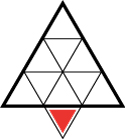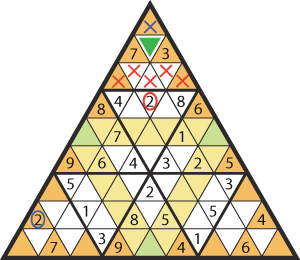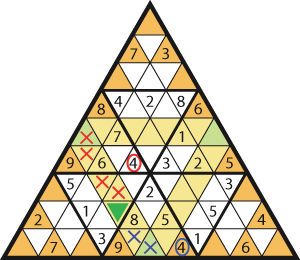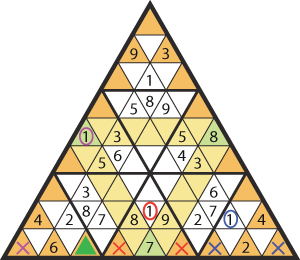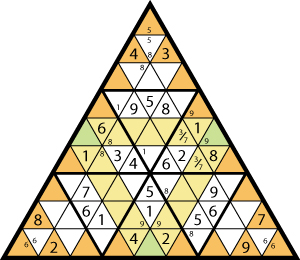
| Tridoku Home |
| Tridoku is a logic puzzle in which a solver uses the process of elimination to fill in the puzzle. Since Tridoku is a fairly new puzzle, many advanced techniques are still being explored. On this page, you will find some basic steps to get you started. |
Power Cells Perhaps the easiest (and often most productive) way to start a puzzle is with Power Cells. These are the cells centered along an outer edge of a large triangle.
There are 18 Power Cells in each puzzle, but many of these won’t contain numbers at the start of the puzzle. A Power Cell is so helpful because it uses the Hexagon Rule to reduce the number of cells within a triangle that can contain a given number.
How to use a Power Cell
In this example, we see that the “2” circled in red is a Power Cell that prevents a “2” from occupying any of the lower 5 cells of the top triangle. As a result of the “Outer Triangle Rule,” the “2” circled in blue in the lower left triangle prevents the top cell from being a “2.” The only cell remaining in the top large triangle is the one highlighted in green. This cell must contain a “2.”
Filling in the Inner Triangle After making as much progress as possible filling in the large triangles, it can be helpful to look for numbers that go in the inner triangle. Because of the Inner Triangle Rule, the numbers 1 – 9 must lie in each leg of the inner triangle. This tells us that a “4” must lie somewhere on the left leg of that triangle.
The “4” circled in red prohibits another “4” from appearing in any of the cells marked with a red X. Similarly, the “4” circled in blue prevents a “4” from occupying the cells marked with a blue X. For the left leg of the inner triangle, this leaves only the cell highlighted in green. This cell must be the “4.”
Filling in the Outer Triangle The Outer Triangle Rule states that each leg of the outer shaded triangle must contain the numbers 1 – 9. Therefore, we know that the lower leg of the outer triangle must contain a “1.”
The “1” circled in red prevents a “1” from appearing in the middle cells. Similarly, the “1” circled in blue prevents a “1” from occupying the cells on the right. Finally, the “1” circled in purple prevents a “1” from occupying the far left cell. This leaves only the cell highlighted in green, and it must be a “1.”
Marking Up the Puzzle One strategy that many puzzlers find helpful (especially with more difficult puzzles) is to pencil in some markings to help narrow down the possibilities later in the puzzle. Be careful though – too many markings can lead to a cluttered puzzle or increase the chances of making a mistake.
Finishing the Puzzle The final cells of a puzzle will generally be determined by the Hexagon Rule. When only a few empty cells remain, examine the surrounding cells, and use the Hexagon Rule to complete the puzzle.
In the example shown here, the puzzle is complete except for a few cells. The numbers missing in the lower, left triangle are 1, 4, and 9. The first three rules offer no clues for filling in these cells. The placement of these numbers is dictated by the immediate neighbors of those cells. A “1” cannot appear in the lower two triangles highlighted in green, and a “4” cannot appear in either of the upper two. This leaves a “1” on the top, a “4” on the bottom, and the “9” in the middle.
|
| Tridoku Home |
